Impactful Distraction
Talking while driving poses dangers that people seem unable to see

Glass Background: Pavel Matoušek/stock.xchng; Glass texture in type: Brano Hudak/stock.xchng; Bluetooth Device: KuzovlevA/iStockphoto
“Keep your eyes on the road, your hands upon the wheel.”
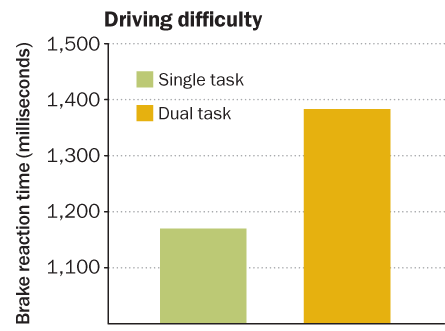
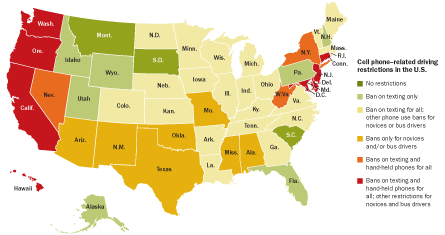
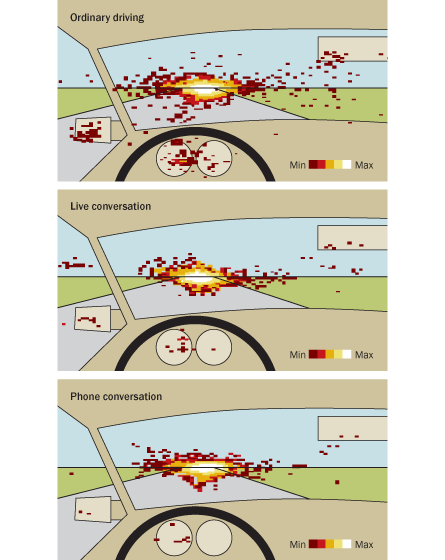
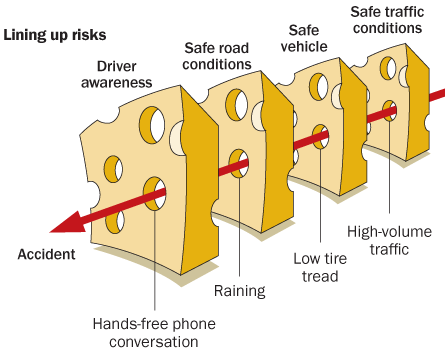
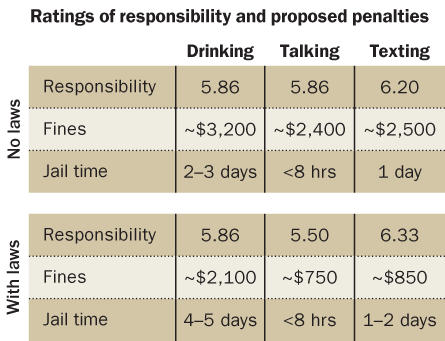
The late rock and roll singer Jim Morrison was not a poster boy for public safety — and was no authority on safe driving. After all, later in “Roadhouse Blues,” he has beer for breakfast. But the opening line of that Doors’ song still resonates as sound guidance.
If only such good advice could stand the test of time. “Roadhouse Blues” hit the airwaves in 1970, long before the unlikely marriage of driving and talking on a cell phone. Millions of people now routinely conduct remote conversations while driving, despite research showing that it’s dangerous — even with two eyes on the road and both hands upon the wheel.
It turns out that hands don’t matter. It’s the conversation that can be lethal. Cell phone conversations impede what a driver sees and processes, a number of studies have shown. That, in turn, slows reactions and other faculties.
This distracted state should be familiar to everyone. “That’s why you can drive home and not remember having driven home,” says Daniel Simons, a psychologist at the University of Illinois at Urbana-Champaign. “Just because you look at something doesn’t mean you see it.”
Simons has shown that people assigned to observe certain activities in a lab setting can totally miss other events occurring in the very same space. The on-road versions of such blind spots show up when drivers engaged in a cell phone conversation fail to look at side streets or watch for pedestrians. This distraction may seem subtle and even fleeting, but it takes a toll: The risk of an accident quadruples when the driver is on the phone, studies have suggested.
Research into driving behavior has produced a three-way disconnect between scientists who study it, legislators who regulate it and drivers who talk on the phone. Majorities of all groups acknowledge that texting while driving is risky (see sidebar). Fewer accept that chatting on a hand-held cell phone while behind the wheel is dangerous. And most drivers and state legislators don’t worry at all about hands-free calls.
As a result, the science of distracted driving has run well ahead of policy. Not a single U.S. state bans hands-free cell phone talking for most adult drivers. Some states limit hand-held cell phone use, but many others apply bans to only bus drivers or novices. Three states have no restrictions whatsoever on calling or even texting while driving.
Public views are also out of sync with the scientific findings, in part because it’s easy and usually harmless to drive while distracted. And many people assume that they can successfully perform multiple tasks simultaneously. But researchers are challenging that assumption. David Strayer, a cognitive neuroscientist at the University of Utah in Salt Lake City, has found that such supertaskers do exist, but comprise only 2.5 percent of people tested. As for the other 97.5 percent, he says, “I suspect they are kind of kidding themselves.”
Split attention
Data began showing up in the 1990s suggesting that cell phones and driving are a poor mix. In 1997, researchers at Sunnybrook Health Sciences Centre in Toronto combed through nearly 27,000 cell phone calls during a 14-month period made by hundreds of drivers who had been in crashes. The average risk of getting into a collision was four times as great when people were on the phone than when they weren’t. Phones with a hands-free option offered no advantage, the researchers reported in the New England Journal of Medicine.
The problem isn’t confined to North America. Scientists in Perth, Australia, checked on people who owned cell phones and who wound up in emergency rooms after car crashes. The researchers compared the likelihood of being on the cell phone before the crash with cell phone use during an uneventful drive at the same time of day one week earlier. The patients were four times as likely to have been on the phone during the smashup, the researchers reported in 2005 in BMJ.
Such observational studies don’t establish cause and effect. So scientists at Complutense University of Madrid actually got into cars with volunteer drivers and distracted them. The researchers had drivers make phone calls using hands-free phones that needed only the push of a button to work. Special vision-tracking devices showed that conversations requiring extra thought or concentration diminished drivers’ extent of visual scanning, speed control, detection of warning flashers and decision-making ability. That study, which appeared in Transportation Research Part F in 2002, still stands as one of the clearest examples of what it means not to give full attention to the road.
Since then, Strayer and his colleagues have fine-tuned understanding of just how incapacitated drivers are when on the phone. In June, Strayer’s team described monitoring 32 drivers in city traffic and asking them to listen to a radio, have a conversation with a passenger, use a hand-held phone, use a hands-free phone or operate voice-to-text technology. Compared with driving free of any distractions, radio was the least problematic, while voice-to-text was the most. The three conversations were about equally distracting and led to substantially degraded driving, marked by less scanning for potential hazards, monitoring mirrors less regularly and showing poor surveillance at pedestrian crosswalks and four-way stops. This effect occurred even though the tasks didn’t require the drivers to take their eyes off the road.
“A cell phone draws attention away from the routines that would provide a good representation of the driving environment,” Strayer says.
Simons calls it inattentional blindness: looking at something and not seeing it. In the most famous demonstration of this phenomenon, six people — three dressed in black and three in white — spend several minutes moving about a room and tossing a ball to each other. Test subjects observe this activity in four 75-second videotapes and are tasked with counting how many times one team passes the ball.
During each video, a brief event occurs that is out of context but plain to see. Either a woman walks across the room holding an umbrella or a person in a gorilla costume passes through. These events each take about five seconds. But when asked afterward if they noticed “anything unusual,” roughly half of the observers don’t recall seeing the gorilla or the umbrella-toting woman. When Simons and a colleague repeated the test with other observers — this time with the gorilla stopping to face the camera and thump its chest — only six of 12 people noticed it.
The study, published in 1999 in Perception, established that people viewing a particular space and concentrating on a task can miss shockingly obvious things (SN: 5/21/11, p. 16). “It reveals how limited our awareness of our environment is, and driving is one context where it matters a lot,” Simons says. Drivers need to be ready for the unexpected. The more distracted a person is, he says, “the less likely you are to see the unexpected.”
Cognitive demand
It’s all part of what scientists call cognitive load. “When we communicate with a person we can’t see, we create a mental image of them,” says sociologist Clifford Nass of Stanford University. The task occupies more available brain power than passively listening to a radio, which requires no interaction.
The more remote the conversation, the more taxing it is. Nass says he realized this after his team told drivers in a test simulation that a voice piped into the simulator was coming from nearby in some cases and from faraway Chicago in others. Although the voice was identical, “people drove significantly worse when they thought it was from Chicago,” he says. The drivers had to fill in more context.
Paul Atchley, a cognitive psychologist at the University of Kansas in Lawrence, says having a remote conversation and driving a car means performing two tasks at once, what some people consider multitasking. But the vast majority of people don’t really multitask, he says — they toggle back and forth between tasks. In so doing, something has to give. When a conversation becomes more dense and complicated, cognitive demand devoted to it increases and that means less brainpower is available for driving.
These decrements change how people drive, and it doesn’t matter where their hands are. A team from Canada found in 2007 that drivers asked to do math problems via cell phone with both hands on the wheel spent more time looking straight ahead and less time scanning the periphery of their vision field — even while cruising through intersections — than people not talking on a phone did. The drivers also slammed on the brakes harder when traffic got sticky, the researchers reported in Accident Analysis & Prevention.
Because driving is often boring and uneventful, drivers get away with these lapses most of the time. That makes the concept of cognitive burden difficult to convey, Atchley says. “It’s hard to explain why talking is dangerous.”
Strayer says people should know better. They experience blank spots in their driving all the time, sometimes at 60 miles per hour. But they fail to perceive the risk of these episodes because these are the very moments when people lack “metacognitive awareness.” That is, they temporarily lose the ability to step outside themselves and monitor how they are doing. They can’t take stock of their own behavior. Metacognitive awareness is important to safe driving because it provides the ability to snap to attention, scan intersections, assess cars far ahead, check the dashboard and assess how well one is driving.
When metacognitive awareness loses out to a cell phone call, Strayer says, “people are not noticing that they are driving badly.” Nor do they recall it later. That’s why even drivers who accept in principle the risks of distracted driving often don’t apply the lesson to themselves. In the January-March issue of Journal of Trauma Nursing, researchers reported that 63 percent of survey respondents still believe they could drive safely while distracted.
It’s the same reason people can acknowledge statistics that prove that airplane travel is safer than driving, Strayer says, but decide to drive because they assume things will be OK if they themselves are behind the wheel.
Risky driving
Jeffrey Coben, an emergency room physician at West Virginia University in Morgantown, has seen the results of plenty of car accidents. He says injuries seldom occur because of chance events, such as equipment failure or lightning strikes. “Vehicle injuries are not accidents. They are predictable and preventable,” he says. “Every crash is an interaction between an individual operating the vehicle and the environment it’s in.” The more distractions involved, he says, the greater the risk.
British scientist James Reason, a specialist in risk analysis, developed what he dubbed the “Swiss cheese” model of risk. He applied it to industrial environments such as nuclear power plants and aircraft carriers. Strayer argues that it fits with distracted driving, too.
The model suggests that a person operating a piece of equipment seldom has an accident, thanks to layers of protection reducing the odds of that happening. Reason portrayed each layer as a slice of indestructible cheese standing between the individual and disaster. “In an ideal world,” he wrote in BMJ in 2000, “each defensive layer would be intact. In reality, however, they are more like slices of Swiss cheese.” When holes in different slices align, a situation becomes hazardous.
In driving, keen attention is often the protective slice that enables the driver to swerve out of harm’s way. But that’s the very slice that is degraded by distractions. Other intact layers might allow a driver to escape harm, such as scant traffic on the road. “An impaired driver may get home without crashing,” Strayer says. Most usually do.
But the safety of a distracted trip hinges on factors out of the driver’s control. The roads might be wet. Traffic could be heavy. There’s drowsiness, road construction, darkness, a novice driver in the oncoming lane. Sometimes there are lots of holes in the cheese. “You need to be able to react,” Strayer says, “because you never know when the other holes will line up.”
Safety versus freedom
Sometime in the future, driving and cell phones may get a divorce. “We might actually look back and say, ‘Well that was really stupid,’ ” Strayer says. “But I don’t know if that’s going to happen.”
Coben favors a strict ban on phone calls while driving but anticipates resistance. “We’ve had similar discussions in other areas. People argued viciously against seat belts, air bags, too,” he says. “Public safety trumps personal freedom in this case.”
But people often don’t readily accept science that angers or inconveniences them, Nass says. And there are built-in obstacles to cell phone regulation. A generation of young adults raised on electronic devices has a high affinity for the gadgets and engages in less face-to-face contact than was once the norm, he says. “Paying attention is less important and is taken less seriously than it used to be, and that’s very consequential for driving. The windshield is just another screen for some young people.”
There have been some changes in attitudes — many people have turned against texting while driving and consider it a problem. But other distractions still get mild scofflaw treatment. Atchley’s team asked volunteers to read hypothetical car-crash scenarios, rate the responsibility of the drivers and mete out justice. The participants reviled drivers who were drunk or texting but handed down harsher “sentences” to the drunk drivers. Drivers responsible for crashes while talking on cell phones got lower fines and milder jail time that was similar to that given to drivers responsible for crashes while not distracted at all.
Katie Womack, a traffic safety researcher at Texas A&M University in College Station, sees parallels between the regulatory histories of distracted and drunk driving. Despite the terrible consequences of drunk driving, she says, at one time “it was still socially acceptable and it took an entire social movement to effect a change.”
There seems to be no social movement against distracted driving afoot in the United States yet. Womack and her colleagues surveyed people visiting Texas motor vehicle departments and asked them to rank how dangerous other drivers’ behaviors were. Using a cell phone while driving came in second-to-last out of nine items, with driving well under the speed limit rated as only slightly less dangerous, she says.
With a lack of social pressure, many states have felt little push to clamp down on the use of cell phones while driving. But states certainly have the power to do so, says Lawrence Gostin, a lawyer at Georgetown University in Washington, D.C. In the eyes of the law, he says, driving is a privilege, not a right.
Gostin has concerns about the future. It may get worse before it gets better. “Cars are already being engineered and redesigned in dramatic ways to increase connectivity,” he says. “This translates into increased distraction. I fear you have the worst combination of industry making big profits on it and consumers really wanting it.”
Texting means trouble
While all distractions impair a driver to some degree, texting while driving draws eyes away from the road for longer than fiddling with the radio or even dialing on a cell phone. Since texting adds to risks already caused by inattention, it takes the prize for distracting drivers the most.
A 2006 study in Australia found that texting quadrupled the time that young drivers took their eyes off the road, leading to swerving and other poor driving. Texting while operating a driving simulator delayed reaction time, and texting while driving increased crash risk by 23-fold in a study of truck drivers at Virginia Tech.
James Hedlund, a consultant in Ithaca, N.Y., for the Governors Highway Safety Association, says regulation of electronic devices involves balancing how much risk society will accept in exchange for the convenience or benefit they provide — and texting is losing out.
Texting has become the whipping boy of distracted-driving regulators, who have now banned it in 41 states and the District of Columbia. AT&T, in recent cell phone billing mailers, cites the National Safety Council in announcing: “100,000+ crashes a year involve drivers who are texting — no text is worth the risk.” Public service announcements on television describe real-life tragedies of accidents caused by texting.
But the texting war is far from over. Recent analyses show that more than 40 percent of high school drivers surveyed had texted while driving in the previous month. “There’s a very strong generational issue here,” Hedlund says. Texting has become routine for people under age 25 or 30, he says. “It’s so ingrained into daily life that it might be really tough to separate that from driving.”
While researchers applaud bans on texting while driving, some have concerns that state legislators are pouncing on texting while leaving other distractions unregulated. “People just choose the easiest target,” says lawyer Lawrence Gostin of the Georgetown University law school. The wide variation among state laws nonetheless reveals a clear trend — a clampdown on texting with no uniform bans on hands-free calling.
“It sends a very bad message,” Gostin says, “that we don’t take this very seriously.” — Nathan Seppa







